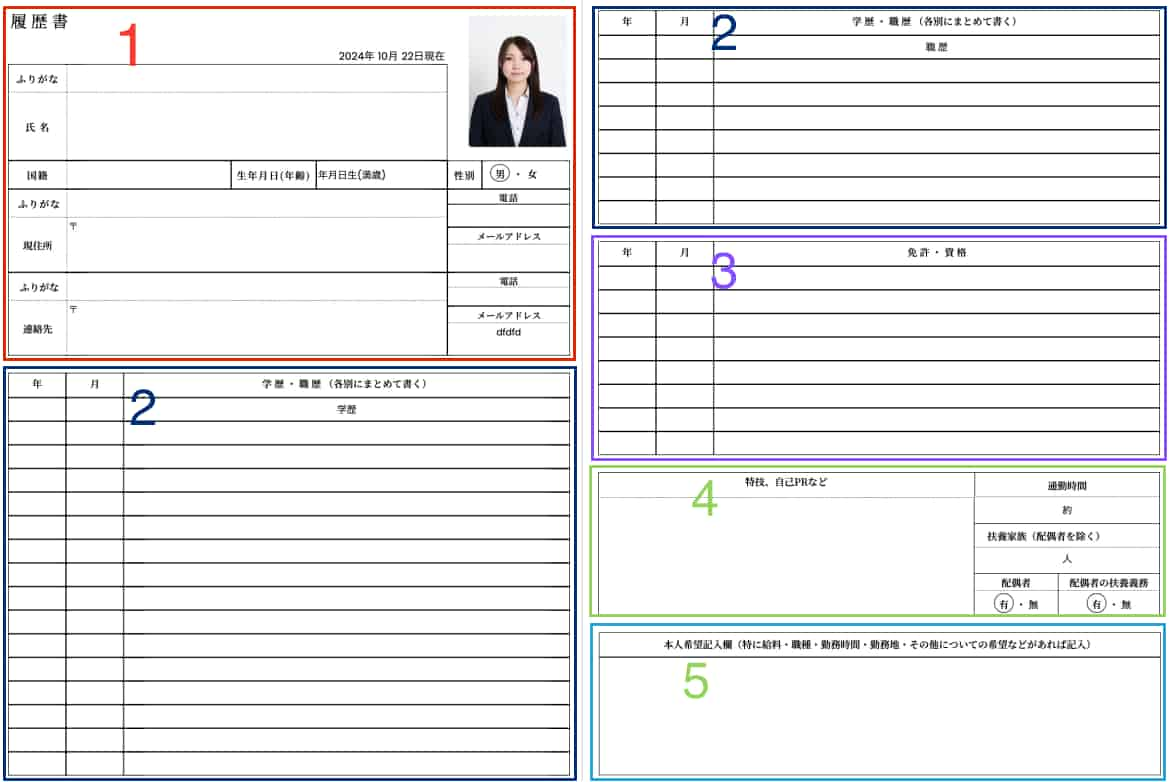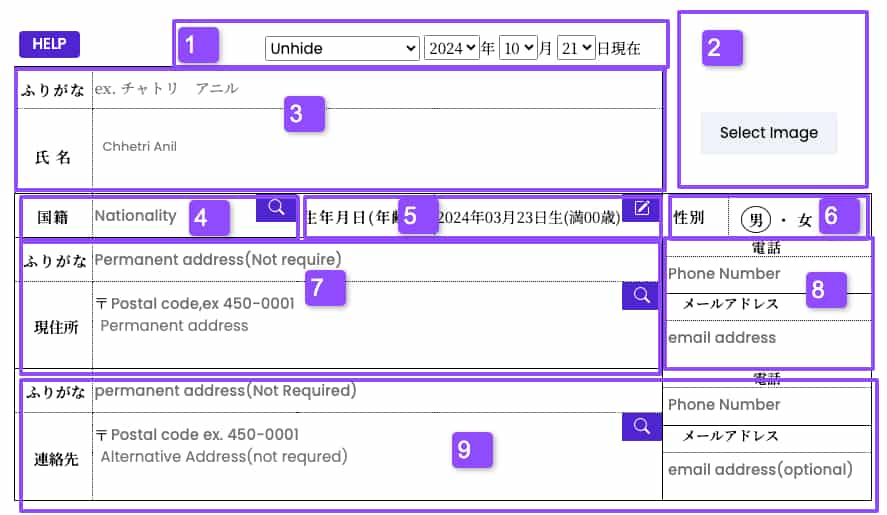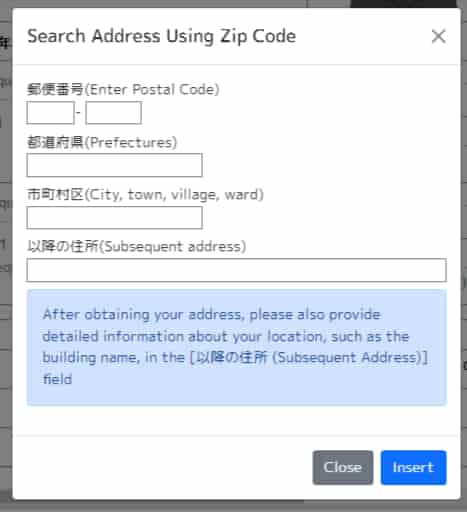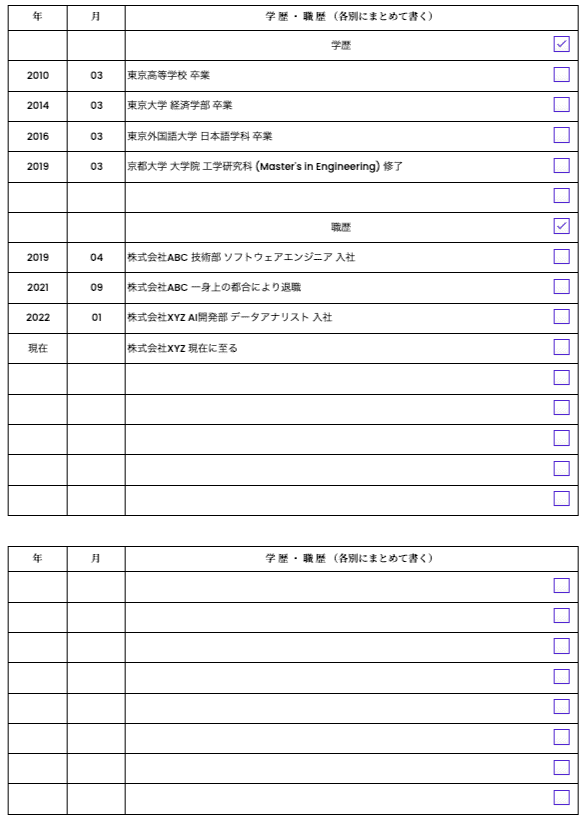Guide to Writing a Japanese Resume
When applying for a job in Japan, whether it is a full-time or part-time position, you will generally need to submit a resume. The format of a Japanese resume differs slightly from those in other countries.
On this page, you will learn how to write a Japanese resume. This type of resume is unique to Japan and often includes specific expressions that may not be commonly used elsewhere. However, once you understand the format and guidelines, creating one becomes a straightforward process.
The Japanese resume is divided into the following five major sections:
This guide will walk you through the process of writing a Japanese-style resume using our Rirekisho Builder. By following these steps, you can easily input your information and generate a resume that follows the official Japanese format. Once completed, your resume will be available for download as a PDF, ready to use for your job applications in Japan.

1. Basic Personal Information

1. Date of Resume Submission
Select the date from (Year / Month / Day ) select option in which day you will submit your resume. If you want to write Date by yoursel(In your handwriting) Select hide option to hide the printed date.
2. Applicant photo
You can change the image by click on that select image and upload the image.
Guidelines to Japanese Resume Photo
- Make sure your're looking straight forward, and your face should be visible clearly.
- Avoid casual clothes and wearing a suit and tie make a good impression.
- It good to use plan solid background.
- The picture should be well-lit and of good quality, with a professional appearance.
- If you have body tattoos, ensure tattoos are covered in the photo.
- Look directly into the camera with solid eye contact, showing confidence.
3. 氏名-Full Name
This is the section for enter your name. Enter your full name in Hiragana. You can also use Katakana which is typically used for foreign names. In front of 氏 名 - since the name is already enter in [furigana], So you can type your name in English. If your are from japan, china or korea, Please write in khanji. First Enter your Last Name then give a space and enter First Name.
4. 国籍-In this section please type your nationality.
In this section you can add your nationality. Our system lets you either type it in or use the search option to find and choose it easily.
5. 生年月日(年齢)- In this section select your date of birth.
6. 性別 – Gender.
Our system allows you to simply click on your gender to select it.
7. 現住所 [Current Address]
In this section please enter your current address. In this section the first fild is say ふりがな[FURIGANA]. Here you have to write your address in Hiragan or Katakana.Follow these steps while using the Rirekisho Builder to make it easier to enter your address in Japanese.
Click in this search Icon for getting your address from your POSTAL CODE

This Popup will open.

Now click on Insert button to add this in your resume.
8. 電話,メールアドレス - Telephone number,E-Mail
Enter your phon number and an email address, where you can be contacted. If you live overseas, be sure to include the country code(phone-number) as well.
9. Contact Information (Optional)
This section is optional. You only need to fill it out if you have a different address from what you entered in sections 7 to 8.
If the company is unable to reach you through the contact details provided earlier, they will use the information you enter here as an alternative. If there’s no need for an additional contact, simply write “同上” (same as above) or leave it blank.
2. Academic/Work History

1. Academic Background (学歴)
This section should list your educational history, starting from high school and progressing to the most recent academic institution you attended (e.g., university or graduate school). This section helps employers understand your educational background and qualifications.
How to Write the Academic History Section:
- In a Japanese resume, this section starts with 学歴 at the center. To make it easier for you, this system has already aligned it at the center, so you can simply continue.
- When adding your education information, start with the earliest entry and list each school or university you attended in chronological order, from the oldest to the newest.
- For Year and Month, type the year and the month you entered or graduated from each institution.
-
In the main input field, write the full name of the school or university you attended. Mention the department or faculty for higher education (e.g., 経済学部 for Faculty of Economics).
入学 (entered) and 卒業 (graduated) should be used to indicate the start and end dates for each institution. - NOTE: If you studied abroad, include the name of the institution and the country in the same format as Japanese schools.
2. Work History (職歴)
This section should list your work experience, starting with the first job you had after your education and progressing to your most recent position. This section shows your career development and the relevant experience you bring to the job you're applying for.
How to Write the Work History Section:
-
Leave one line below your Academic Background and write 職歴. To make it centered, select the checkbox.
- Start with your first job after graduation and list each position in chronological order, from the oldest to the most recent.
- For each entry, include:
- Type the year and month you joined or left each company or position using the Year and Month options.
-
Write the full name of the company or organization. Specify your department or role (e.g., ソフトウェアエンジニア for Software Engineer).
入社 (joined company) and 退職 (resigned) should be used to indicate when you started and ended each job. If you are currently employed, use 現在に至る to indicate that you are still working there.
- If you left a job for personal reasons, you can use 一身上の都合により退職 (resigned for personal reasons) after each company name.
If There’s Not Enough Space
-
Leave one line below your Academic Background and write 職歴. To make it centered, select the checkbox.
- Start with your first job after graduation and list each position in chronological order, from the oldest to the most recent.
- For each entry, include:
- Type the year and month you joined or left each company or position using the Year and Month options.
-
Write the full name of the company or organization. Specify your department or role (e.g., ソフトウェアエンジニア for Software Engineer).
入社 (joined company) and 退職 (resigned) should be used to indicate when you started and ended each job. If you are currently employed, use 現在に至る to indicate that you are still working there.
- If you left a job for personal reasons, you can use 一身上の都合により退職 (resigned for personal reasons) after each company name.
If There’s Not Enough Space
In the japanese resume there are two section for Academic or work history. If there isn’t enough space in the first section for your academic or work history entries, you can continue in the next section. Clearly label the continuation as 学歴 (continued) or 職歴 (continued) to keep the sections organized.
3. Licenses or Qualifications

The "Licenses and Qualifications(免許・資格)" field on a Japanese resume (履歴書) is where you list any licenses or certifications you've obtained that could be relevant to the job you're applying for. This section is important because it demonstrates any special skills or qualifications that may set you apart from other applicants.
1. Correct Acquisition Year:
It's important to select the exact year and month when you received each license or qualification, as it reflects your timeline of professional development.
2. Official Name:
In third colum,you must write the official names of the licenses or certifications, not abbreviations or nicknames. This ensures clarity and professionalism.
Example:
Let’s say you have the Japanese-Language Proficiency Test (JLPT) N3 certificate. Here's how you would write it in the "Licenses and Qualifications" section:
| 年 | 月 | 免 許 ・ 資 格 |
|---|---|---|
| 2023 | 12 | 日本語能力試験 N3 合格 |
4. Special Skills, Self-Promotion, Commuting Time, etc.

1. 特技・自己PRなど – Special skills, self-PR, etc.
In this section you can showcase your Special skills, self-PR, etc.
So when wrting this, focus on skills that are directly applicable to the job you're applying for. This could include technical skills, language proficiency, project management abilities, or any specific expertise relevant to the industry.
2. 通勤時間 – Commuting time
Please provide your travel time from home to work. For example, if it takes 30 minutes, write "30分" as 約 already writen. If it takes 1 hour, enter "about 1 hour 1時間".
If you are currently living overseas or in a place where you cannot travel from your address in Japan, you can skip this section.
3. 扶養家族(配偶者を除く)・配偶者・配偶者の扶養義務 – Dependents (excluding spouse), spouse, spouse’s obligation to support
Dependents (扶養家族) are family members who rely on your income. It's important to list your dependents on your resume because the company needs this information to calculate income taxes and apply for social insurance, like health insurance.
-扶養家族(配偶者を除く): In the "Dependents (excluding spouse)" (扶養家族(配偶者を除く)) section, enter the number of dependents you have, excluding your spouse.
Example
- For example, if you have a spouse and three children, you would write "3" because the spouse is not counted.
- If one of your children is already earning their own income, you would enter the number of dependents as "2" (excluding your spouse).
配偶者 In the "Spouse" (配偶者) section, if you are married, Click on " (有)". If you are not married, Click "(無).
配偶者の扶養義務: In the Spouse’s Support Obligation" (配偶者の扶養義務) section:
- If you support your spouse with your income, click on " (有)".
- If your spouse works and has social insurance at their job, click on "(無)".
- If your spouse works but does not have social insurance, and you need to apply for social insurance for them at your company, click "Yes (有)".
5. Space for Personal Requests

In this section, you can specify your preferences for work conditions, such as job description, work location, salary, and more. However, it is common practice to write “I will comply with your company regulations (貴社規定に従います)”.
